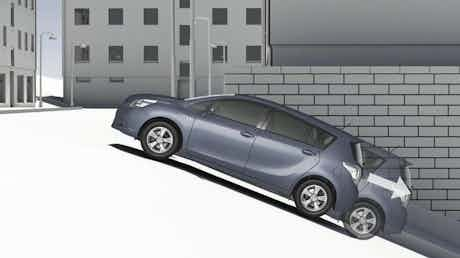What is hill start assist?
January 16, 2023 by carwow staff

Wondering what hill-start assist is, how it works or if it’s worthwhile? Wonder no more.
Driving involves learning a number of skills. Some, like observation and anticipation, are general principles while others, like clutch control, are specific skills.
Knowing how to perform a hill start is another specific skill. A hill start, just to make clear from the beginning, is the process of moving off from an incline without the car rolling backwards or forwards.
Modern technology can play a hand to make life easier here, and hill-start assist is an electromechanical feature that can remove the need for you to go to the hassle of performing a hill start yourself.
How to perform a hill start
Hill starts tend to be simpler in cars with automatic gearboxes, as you can simply keep the gearbox in ‘D’ with your foot on the brake when stopped on a hill, then the gearbox’s ‘creep’ function moves the car forward as soon as you take your foot off the brake. Even if you put the gearbox into ‘N’ (this is kinder to the transmission if you’re stopped for more than a few seconds) you can keep your foot on the brake as you put it back into D, waiting for the transmission to creep forward when you take your foot off the brake.

In a car with a manual gearbox the process is more involved, and typically calls for the handbrake to be used; this prevents the car from rolling backwards, and you release the handbrake as you engage the clutch and it meets its biting point. This requires careful timing: release the handbrake too early and the car could roll backwards, but release it too late and you could stall the car as the engine is trying to move the wheels when the handbrake is trying to keep the car stationary. It is also possible to perform a hill start using the foot brake instead of the handbrake, though this requires fleet feet.
What is hill start assist technology and how does it work?
Convenience is one of the biggest selling points in the world, so it’s little wonder that car makers constantly release features that aim to make life simpler.
Hill-start assist, also known as ‘hill hold’, is one such system and it makes use of inclinometer sensors that can tell when a vehicle stopped is on a hill.
When this scenario is detected, hill-start assist keeps the brakes applied for a couple of seconds after you remove your foot from the brake pedal, giving your time to move your foot to the accelerator and move off. If your car has a manual gearbox and hill-start assist, the system will keep the brakes applied until you bring the clutch pedal up.
And while modern cars increasingly come with electronic handbrakes, hill-start assist can also be found in cars with manual handbrakes.
Oh, and don’t confuse hill-start assist with auto-hold brakes: the latter uses similar technology, but sees the driver push then release the brake pedal when stopped in traffic, and the auto-hold brakes keeping the car stationary until the accelerator is applied, or the brake pedal pushed again.
You can use auto-hold on hills, though, at which point it effectively fulfils the same function as hill-start assist. Just to make things even more granular, cars with auto-hold brakes may have hill-start assist as well, as the latter automatically applies the brakes, whereas the former is activated by a deliberate shove of the brake pedal. Consult your vehicle handbook for further information, as they say.
Do I need hill start assist?
Hill starts are one of the components that can be assessed during the driving test, so it’s likely you will have been taught how to perform one during your driving lessons – therefore no, you don’t technically ‘need’ hill-start assist.
But then do you ‘need’ anything other than protein shakes and vitamin pills to live? Do you ‘need’ to watch television, go to the theatre or listen to music? No – but we like to do things that enhance our lives and, in the stop-start traffic that has become so prevalent since car ownership exploded over the last few decades, chances are you will find yourself stopped on an incline from time to time, at which point hill-start assist can be a nice feature to have, and can make life just a little bit simpler.
Cars with hill start assist
Almost every car on sale today comes with hill-start assist as standard – even the entry-level Kia Picanto and Dacia Sandero – two of the most affordable cars on sale today – get it in entry-level trim.
Do be sure to check if any specific model you’re interested in has hill-start assist if this is an important feature for you, though, as models that have been on the market for a while may not necessarily have it, or may offer it only on higher trim levels.
Do electric cars need hill start assist?
Yes, EVs do have hill-start assist. The system may work using the motor to keep the car stationary rather than the brake pads being automatically applied, but electric cars do indeed come with hill-start assist. The laws of physics apply to all cars, whatever fuel they use, and an incline will always see a wheeled vehicle move unless it is prevented from doing so.
Cars Change? Carwow!
Looking for a new set of wheels? With Carwow you can sell your car quickly and for a fair price – as well as find great offers on your next one. Whether you’re looking to buy a car brand new, are after something used or you want to explore car leasing options, Carwow is your one stop shop for new car deals.















